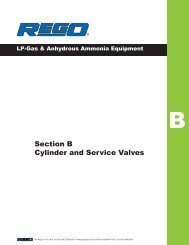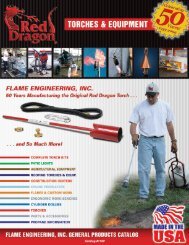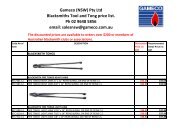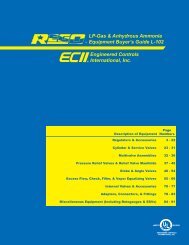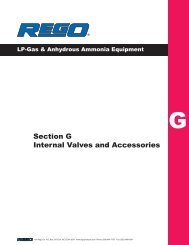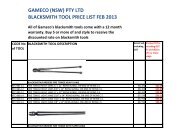Repair Kits Available By Part Number Section 2 Page - GAMECO
Repair Kits Available By Part Number Section 2 Page - GAMECO
Repair Kits Available By Part Number Section 2 Page - GAMECO
You also want an ePaper? Increase the reach of your titles
YUMPU automatically turns print PDFs into web optimized ePapers that Google loves.
5. Remove the bonnet by turning it counter-clockwise.<br />
Carefully slide it off the end of the stem. Save for reassembly.<br />
6. Slide the packing out from the inside of the bonnet.<br />
Remove and discard. Remove the bonnet gasket from the<br />
back of the bonnet and discard.<br />
NOTE: The bonnet gasket may be lodged on the machined<br />
surface inside the manifold body.<br />
7. Remove the washer located behind the bonnet by sliding it<br />
over the end of the stem. Discard.<br />
8. Clean and wash all threads and surfaces on the bonnet<br />
thoroughly.<br />
Reassembly:<br />
1. Slip new washer over stem and slide it down until it contacts<br />
the retaining ring.<br />
2. After applying a light coating of grease or anti-seize lubricant<br />
to the stem and bonnet cap gasket, stick the bonnet cap<br />
gasket to the sealing surface on the bonnet.<br />
3. Apply a thread locking compound to the main threads on<br />
the bonnet. Slide the bonnet down the stem and tighten.<br />
4. Install new packing by sliding it down the stem and into the<br />
bonnet.<br />
5. Slide gland onto the stem and tighten using a 9 /16" wrench.<br />
6. Insert new Woodruff Key into the slot on the end of the stem.<br />
7. Slide handle assembly down the stem unit it is centered over<br />
the Woodruff Key.<br />
8. Secure handle to the stem by installing new set screw and<br />
tightening.<br />
9. Work the handle back and forth several times for even<br />
distribution of lubrication.<br />
NOTE • If the handle is too tight and will not move, loosen the<br />
gland until handle moves with a fair amount of ease.<br />
See Step 5.<br />
• If the handle moves too freely, it is an indication that<br />
the gland is too loose. The gland must be tightened<br />
or it will leak.<br />
Re-Installing the Manifold Assembly<br />
If the manifold was removed from the container, replace with the<br />
following steps:<br />
1. Apply a suitable non-hardening pipe compound to the male<br />
threads of the lower manifold body.<br />
NOTE: Do not apply compound to the female threads in the<br />
container coupling.<br />
2. Thread the manifold into the container port hand tight.<br />
3. Using an appropriate wrench applied directly to the lower<br />
body of the manifold, tighten the manifold into the container<br />
with a sufficient torque to provide a leak tight seal.<br />
Relief Valve Replacement<br />
1. Apply a small amount of a suitable non-hardening pipe<br />
compound to the male threads of the relief valves.<br />
NOTE: Do not apply compound to the female threads in the<br />
manifold port.<br />
2. Thread relief valves into manifold assembly hand tight.<br />
3. Using an appropriate wrench on the hex section of the relief<br />
valves only, screw valves in approximately 1 1 /2 additional<br />
turns. Tighten valves with a sufficient torque to provide a<br />
leak-tight seal.<br />
Placing Relief Valve Manifold Back into Service<br />
Turn the knob of each bleeder valve counterclockwise until it is<br />
fully back-seated. See Figure 2. During normal operation, the<br />
bleeder valve should be left in this position.<br />
During normal operation, with the relief valves properly in place,<br />
the positioning handle should be kept at the center stop<br />
position. In this position, both relief valves are open to the<br />
container vapor space, providing extra relief capacity by<br />
permitting both valves to function simultaneously if necessary.<br />
Check the connection of the replaced relief valves and manifold<br />
using a high quality leak detection solution. If bubbles appear,<br />
there is a leak. The connection must be leak tight.<br />
Key for Figure 3<br />
Figure 2: Bleeder Valve Detail<br />
Detail of Bleeder Valve<br />
shown in back-seated<br />
position – normal operating<br />
position. Permits<br />
equalization of pressure<br />
on both sides of shut-off<br />
disc after relief valve has<br />
been reinstalled.<br />
Detail of Bleeder Valve<br />
shown in closed position.<br />
Permits pressure trapped<br />
between relief valve and<br />
shut-off disc to be bled off<br />
so relief valve can be<br />
removed.<br />
Key Description (Qty.) <strong>Part</strong> <strong>Number</strong><br />
1 Bleeder Valve Assembly (2) In <strong>Repair</strong> Kit<br />
2 Positioning Handle Assy. A 8540-11<br />
3 Instruction Plate A 8540-28<br />
4 Washer In <strong>Repair</strong> Kit<br />
5 Stem A 8540-6SS<br />
6 Woodruff Key In <strong>Repair</strong> Kit<br />
7 Set Screw In <strong>Repair</strong> Kit<br />
8 Gland In <strong>Repair</strong> Kit<br />
9 Packing In <strong>Repair</strong> Kit<br />
10 Bonnet A 8540-2<br />
11 Bonnet Gasket In <strong>Repair</strong> Kit<br />
12 Retaining Ring A 8540-26SSA<br />
13 Seal Ring Seat Assembly A 8540-16T<br />
14 O-Ring A 8540-21<br />
15 Disc Assembly A 8540-12<br />
16 Bleeder Valve Seat A 7560-35<br />
PAGE 2



